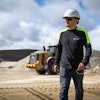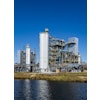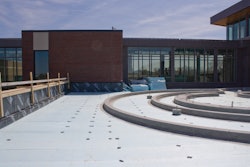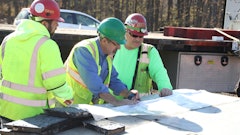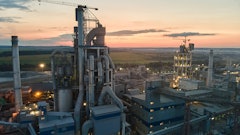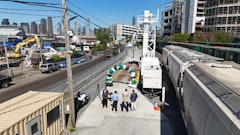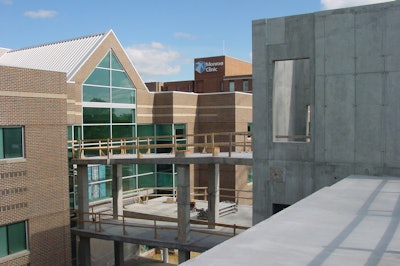
Monroe Clinic in Monroe, Wisconsin, has committed to voluntarily achieving Leadership in Energy and Environmental Design (LEED) Silver Certification for its soon-to-be-finished Northwest Addition.
The $83 million addition will house both hospital and clinical services, providing expanded and convenient access to healthcare for the 25 communities in southwest Wisconsin and northwest Illinois.
Expected to open early next year, the addition will span approximately 225,000 square feet on four levels. Included in the space will be 32 private inpatient rooms; seven private birth suites; an emergency department and ICU; a cardiac clinic and rehabilitation unit; medical imaging; surgical suites (including day surgery); a cafeteria; lobby and admissions area; chapel and rooftop gardens.
“This project has been a challenging, but rewarding, process,” says Steve Borowski, Director of Facility Services for Monroe Clinic. “Our decision to pursue LEED Certification was driven by our community as well as our organization. Being a Catholic sponsored organization, stewardship of resources is an important part of who we are. The basis of LEED program speaks to the heart of Monroe Clinic’s commitment to the communities it serves.
“We strongly believe sustainable building is the right thing to do,” Borowski adds. “We desire both the accountability and the proof that LEED certification brings. It’s a source of pride for our community and our organization, and it’s attractive to physicians and staff who want to be associated with an environmentally progressive organization.”
Unique challenges for healthcare
Nationally, just 3% of current LEED-certified projects are healthcare-related and most are not as energy-intensive as hospitals, which care for patients on a 24/7 basis.
Inpatient healthcare facilities face unique challenges when applying sustainable building practices, explains Chuck Bernhagen, Project Manager for Monroe Clinic. Unlike office buildings, inpatient hospitals operate around the clock under strict healthcare-imposed regulations. These regulations eliminate many obvious energy conservation tactics that can more readily be implemented by less regulated, less inhabited office buildings.
LEED certification for healthcare is relatively new and as a result, Monroe Clinic is applying for LEED Silver certification under the original, more stringent, non-healthcare LEED standards. When the project is complete in early 2012, Monroe Clinic may become the first Wisconsin hospital to achieve LEED Silver Certification status.
Community and staff involvement
To make sure the hospital didn’t miss a thing, management brought the community and staff into the planning of the Northwest addition. “We conducted research with community members and incorporated their vision into ours,” says Borowski.
More than 200 Monroe Clinic employees dedicated more than 4,000 hours to ensure that nothing has been overlooked on the project. “Champion teams” and “design teams” comprised of providers, nurses, managers and other employees worked diligently to provide project direction and help design the campus expansion.
“The extent and depth of employee involvement is unusual,” says Bernhagen, who has led healthcare construction projects for several systems in the Midwest. “There was a concerted effort to get the full picture and do things right on a scale I haven’t seen before,” he explains.
Shawn Webb, Decision Support Specialist, was a member of the sustainability/green/LEED team. After getting a crash course in environmental sustainability and healthcare, Webb says she’s more aware of how she can make a difference both personally and professionally. She’s excited that her team helped make the case for Monroe Clinic’s decision to become one of the first hospitals to pursue LEED certification.
The savings are already here
Monroe Clinic has already made significant efforts to lessen its impact on the environment. Housekeeping staff use green cleaning products and water-conserving microfiber mops. The changes didn’t increase costs or compromise infection control, Borowski explains. Through an employee education campaign, Monroe Clinic has also reduced the amount of medical waste it produces. This has saved significant money because removing medical waste is much more expensive than regular waste.
Salvaged appliances, wood cabinetry, light fixtures, radiators and windows removed from houses razed during the parking lot construction have already been given a new life in Habitat for Humanity and other projects. Bricks and foundation materials were used as base for parking lots. In all, the project expects to divert a full 75% of construction wastes away from landfills. (The project has diverted 90% in work done to date.)
While building green typically adds 2 to 3% to construction costs, Borowski says Monroe Clinic expects to more than recoup the costs over time. “We are looking at a payback of less than five years for many of our LEED-certified elements, especially with some of the larger mechanical equipment” confirms Borowski.
“In the scheme of the whole project, LEED certification is just another moving part,” explains Borowski. “If you want to do it the right way and get the results you are looking for, you have to go the extra mile.
“When we discovered some of these technologies, it was such a win-win situation,” Borowski adds. “We will see lasting savings on utilities while providing a beautiful, restful environment for our patients, staff and guests.”


